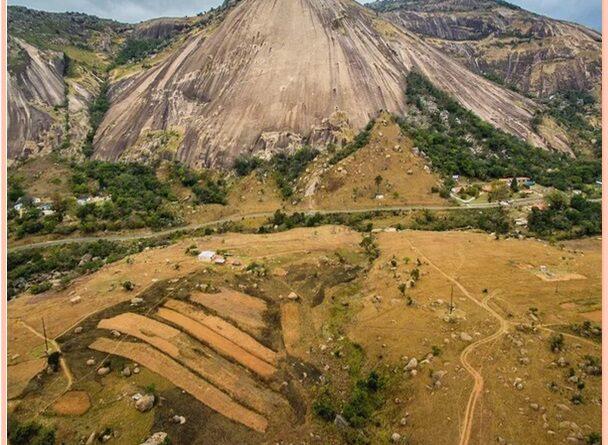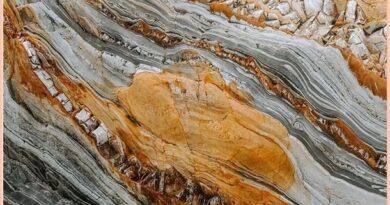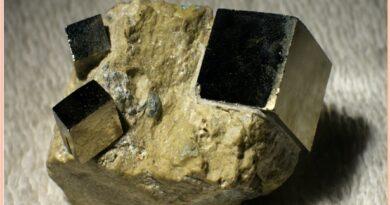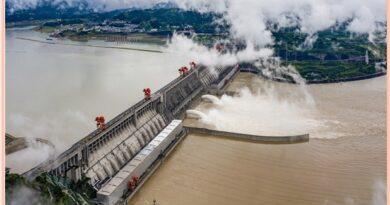Igneous Pluton-Emplacement and Type
What is Igneous Pluton
A pluton is a general term that refers to any igneous body that was emplaced and crystallized beneath the Earth’s surface. Plutonic rocks are characterized by a coarse grain crystal texture in which individual crystals can be easily seen by the naked eye. The word plutonic is derived from the name of Pluto, the Greek god of the underworld. The majority of granitic magmas are formed by melting near the base of the continents. The magmas slowly rise through the crust like great balloons and solidify near the surface to form gigantic bodies of igneous rock called Plutons. These Igneous plutons are exposed later when uplift and erosion remove the overlying rock.
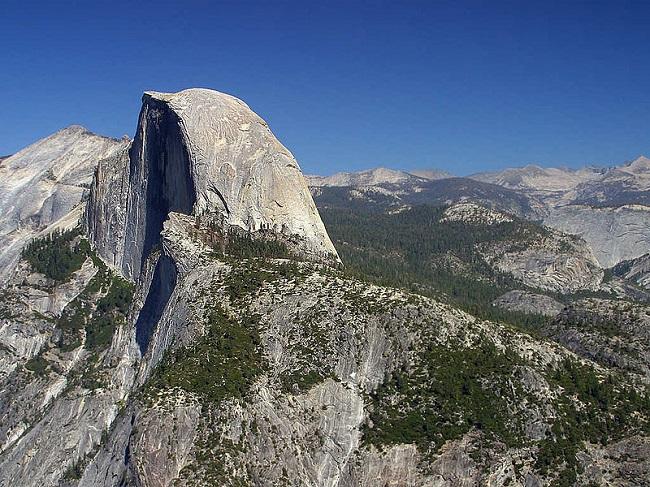
Composition of Plutonic bodies
The composition of plutonic rocks included mafic (Gabbro and Diorite) to felsic (Granodiorite and granite ), and the coarse crystalline texture develops because plutonic rocks are insulated by the surrounding country rock and cool very slowly. Plutons are classified according to their size, shape, and relationship to the surrounding rock. Plutonic structures include huge solidified magma chambers. It includes Dikes, batholiths, laccoliths, stocks, sills, and other forms of intrusion. Plutons commonly develop beneath strings of volcanoes associated with plate subduction. Batholiths may contain hundreds of plutons intimately penetrating one another. The Sierra Nevada range of California and the Andes literally define the notion of batholiths. The body inflates in place just as do other bodies that begin as necks and locally balloon into a pluton. Although the area of plutons can be enormous, Many plutons are equivalent to spheres of diameters of 2–10 km.
Pluton Emplacement Mechanisms
The volume of magma that intruded from the Earth’s crust is enormous. Since the plutons typically intrude into preexisting continents, the magma in these plutons had to create space in the crust for it to intrude into them. Geologists have long speculated on how such large volumes of magma intrude the crust, and how volcanic eruption occurs. One mechanism is assimilation, which operates magma melts surrounding rocks to rises upward. In doing so the magma becomes cooler, and its composition changes to reflect the added melted country rock.
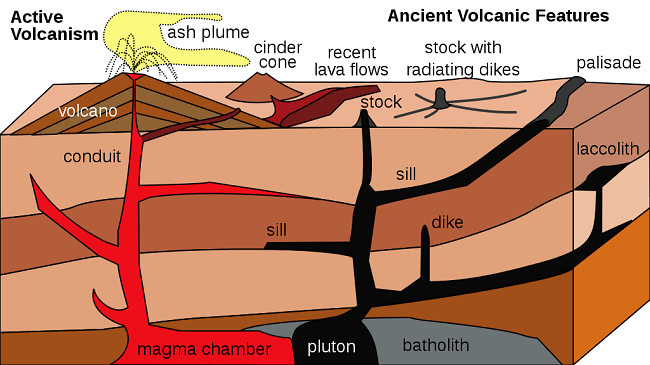
Assimilation causes magmas to rise only a limited distance, so, High pressure can force some magmas into the crust. one variation of this forceful emplacement style is diapirism, where the weight of surrounding rocks pushes down on the melt layer, that squeezes up through cracks that can expand and extend, forming volcanic vents at the surface. Most Plutons seem to be emplaced into structures such as faults, the weakness provided by the structure for the emplacement of the magma. some plutons are emplaced into active faults, intruding into spaces created by gaps that open between misaligned segments of the moving fault zone.
Glucofort-Unique and best Blood sugar support-click here
Types of Igneous pluton
Common types of igneous Pluton include Dikes, Sills, Lopoliths, Laccoliths, Cone sheets, Ring dikes and Bell-jar intrusions, Funnel-shaped intrusions, Batholiths, Stocks, and Plugs. Some of the most common types of intrusive bodies are dikes and sills. This intrusion of Pluton is broadly divided into two forms-Discordant intrusions, cut across the preexisting structure of the country rocks, while concordant intrusions intrude parallel to existing bedding or fabric.
Discordant Igneous body
Cone sheets, ring dikes, and funnel intrusions are all discordant bodies. A cone sheet is a thin dike (1 meter to several meters) with the form of a downward-pointing cone, causing it to display a circular outcrop pattern. The diameter of the cone sheet may vary from meters to several kilometers.
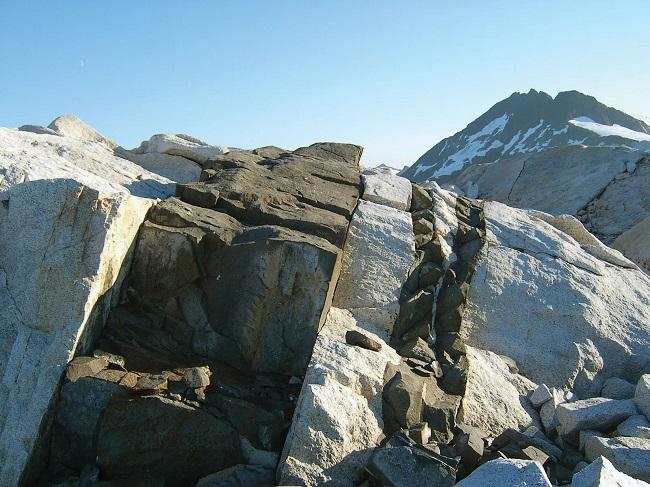
Ring Dikes
Ring dikes are circular in outcrop and reflect their upward-pointing, truncated conical form. They are typically inclined outward at a steep angle. Dikes vary in thickness from meters to kilometers. The diameters range from several kilometers to several tens of kilometers. Ring dikes are commonly surmounted by a bell-jar intrusion, which is effectively a disk-shaped sill.
Both structures result from the vertical subsidence into an underpressure magma chamber of the block of country rock at the center of a ring dike. If the ring fracture penetrates to the earth’s surface, a circular crater known as a caldera is formed and magma erupts within the crater.
Funnel-shaped intrusions
Funnel-shaped intrusions are mostly intrusions of basic and ultrabasic rocks. This body has the shape of a champagne glass with two feeder pipes at the base. These intrusions are described as funnel dikes. But they can be very large. For example, the Great Dike in Zimbabwe is over 500 km long, several kilometers wide and up to 3 km thick.
Also, Read- Mining projects and their impact on environmental stability
Batholith
A batholith is a group of plutons of various shapes, sizes, and rock types that have accumulated and intruded on one another over a long interval of time. Batholith forms a linear belt up to hundreds of kilometers long and tens of kilometers wide, like-the Sierra Nevada batholith of California. Most batholiths have granitoid composition but can include gabbros and even ultramafic rocks. The term is also used for a single, steep-sided, granitoid intrusion, circular-ovoid in the plan, and of great vertical and areal extent.
Lose your weight with perfect shape-click here
Phacolith
Phacolith is a lens-shaped mass of igneous rock intruded in folded sedimentary beds that is concordant and has its greatest thickness along the axes of synclines or anticlines.
Dike
A dike is a sheet of rock that is formed in a fracture of a pre-existing rock body. It is a Discordant igneous body. Magmatic dikes form when magma flows into a crack then solidifies as a sheet intrusion, either cutting across layers of rock or through a contiguous mass of rock.
Concordant igneous bodies
Laccoliths and Lopoliths are variants of sills and Concordant igneous bodies. In this type of eruption, magma is unable to rise higher, spread their magma laterally along bedding planes, and coalesce.
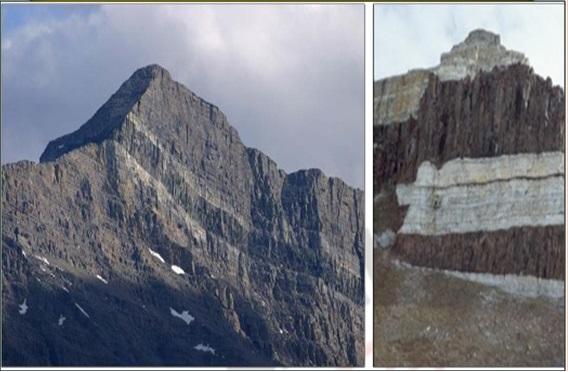
Loccoliths
Laccoliths are lens-shaped and normally 1–2 km at the thickest. They have a planar base but a domed upper surface, above which the country rocks are arched up.
Lopoliths
Lopoliths have a saucer form, implying sagging of the underlying rocks under the weight of emplaced rock; most are several kilometers thick and can be very extensive in area, covering thousands of square kilometers, as in the case of the Bushveld Complex, South Africa.
Sill
Sills is the relatively thin tabular sheetlike body that penetrates parallel to the bedding planes. Sills laterally may extend for 100 kilometers and up to 10 km. in width. Lateral extend mainly depends on the hydrostatic force, temperature, degree of fluidity or viscosity, the weight of the overlying sediments column. Since the basic magma is more fluid than acidic magma-mostly sills are made up of Gabbros and dolerites.
